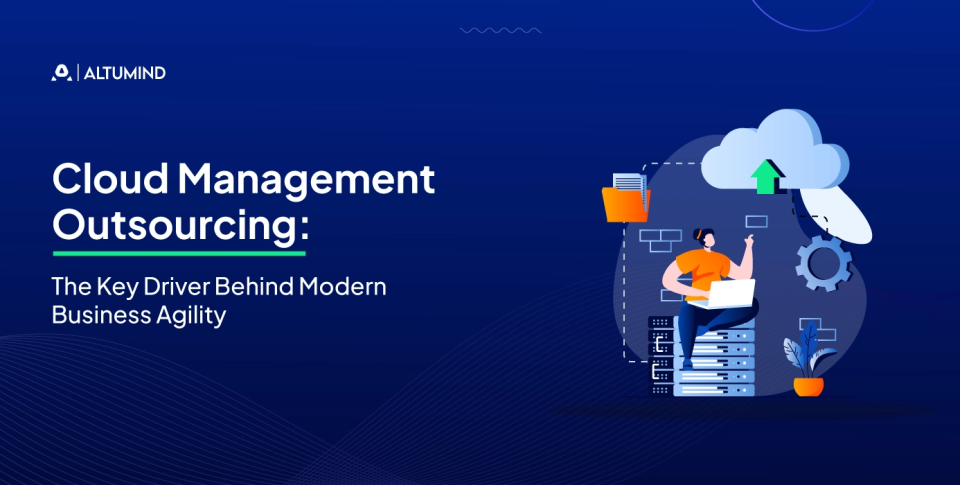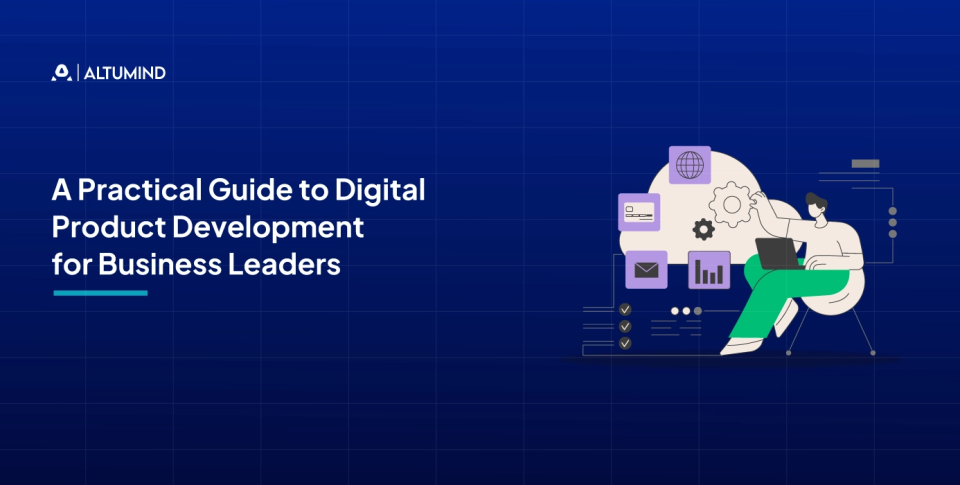6 Ways Cloud Based Analytics is Transforming Business in 2025
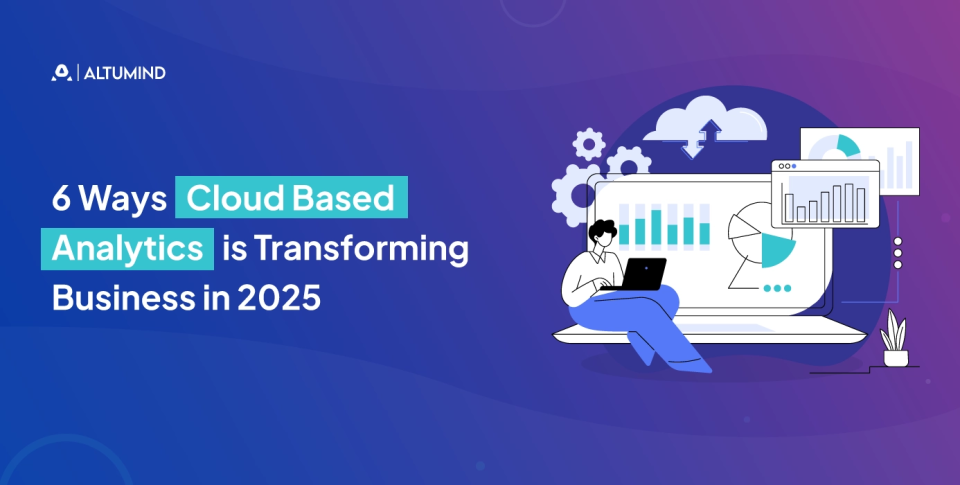
Enterprises today generate massive volumes of data across operations, customers, and markets. Yet much of this information stays siloed, slow to process, and difficult to act on. Traditional analytics systems demand heavy infrastructure, high costs, and rigid setups that can’t keep pace with changing business needs.
Leaders delay or make decisions based on incomplete information when they lack timely insights. This creates risks: missed opportunities, wasted resources, and declining competitiveness. Teams spend more time managing servers and spreadsheets than identifying growth patterns. Security concerns grow as fragmented systems leave gaps. Meanwhile, competitors move faster with smarter tools, making the pressure to act even higher.
Cloud based analytics resolves these pain points by shifting the intelligence layer into a scalable, flexible environment. For decision makers, this is turning out to be a catalyst for smarter strategies and helping them move ahead of market shifts. In this blog, we will look at what cloud based analytics really means for enterprises and how it positions organizations for future growth.
What is Cloud Based Analytics?
Cloud based analytics is the practice of using cloud infrastructure to store, process, and analyze business data at scale. Unlike traditional analytics that depend on physical servers, cloud based analytics operate in a virtual environment hosted by cloud providers.
This shift allows organizations to access virtually unlimited storage and computing power without building costly infrastructure. Data flows in from multiple sources, including business applications, IoT devices, transactions, and customer interactions, and gets processed in real time.
For business owners, this means decisions are not restricted by system capacity or time delays. Instead, insights arrive faster, across departments, and at a scale that supports growth. It transforms raw, scattered information into actionable intelligence while keeping costs predictable and operations secure.
Scope of Cloud Based Analytics
Cloud analytics has shifted from being an operational tool to becoming a strategic driver of business growth. As organizations face rising data volumes, complex decision environments, and pressure to respond in real time, cloud analytics provides scalability, speed, and intelligence that on-premise solutions cannot match.
The global cloud analytics market size was valued at USD 35.39 billion in 2024 and is projected to reach USD 130.63 billion by 2030, growing at a CAGR of 25.5% between 2025 and 2030. This rapid expansion reflects not only the rising adoption of digital platforms but also the shift toward real-time data connectivity across industries.
North America remains the largest revenue generator, with the United States holding a dominant share in 2024. On the solution side, cloud analytics platforms themselves accounted for the largest market share, while public cloud deployments led adoption across enterprises. Among applications, sales and marketing analytics dominated in 2024, while small and medium-sized enterprises (SMEs) are expected to grow at the fastest CAGR of over 27% from 2025 to 2030.
How Cloud Based Analytics Works
1. Data Collection
Every enterprise generates data at multiple touchpoints, from customer interactions and enterprise software to IoT devices and external platforms. This information may be structured, like financial records and sales logs, or unstructured, like social media feeds and customer service transcripts. By consolidating these diverse inputs into a unified stream, cloud based analytics captures the full picture of organizational activity and sets the foundation for meaningful insight.
2. Cloud Storage
Once collected, data is transferred into secure cloud environments such as data warehouses or lakes. These environments are designed for elasticity, meaning they grow or shrink depending on the volume of information. This removes the limitations of traditional servers and allows organizations to manage enormous datasets without heavy infrastructure investment. It also ensures that storage is not a bottleneck, even when information inflow spikes.
3. Data Integration and Processing
Raw information often arrives in fragmented or inconsistent formats. To make it usable, cloud systems apply integration and processing pipelines that clean, validate, and standardize the inputs. Errors, duplicates, and mismatches are resolved during this stage, creating reliable datasets. This preparation is vital because the strength of any insight depends directly on the quality of the underlying data.
4. Analytics Engine
With well-prepared information in place, the analytics engine applies statistical models, algorithms, and machine learning processes. These tools identify patterns, highlight anomalies, and generate predictions. What once required days of manual work now happens in real time, giving leaders immediate visibility into opportunities and risks. Dashboards and visual tools further simplify results so that complex analytics can be understood without technical expertise.
5. Delivery of Insights
The processed results are presented through interactive dashboards, reports, or mobile-friendly applications. Unlike static reports that arrive after delays, these platforms provide real-time access. Leaders can drill down, filter, and compare data points on demand, ensuring the right insights are available at the moment of decision. This immediacy eliminates traditional bottlenecks and supports faster alignment across teams.
6. Decision Execution
The final stage turns analytics into action. Equipped with reliable and timely insights, executives can refine strategies, adjust operations, and allocate resources more effectively. Whether improving customer experiences, streamlining supply chains, or guiding investment priorities, cloud based analytics closes the loop between data and decision. This cycle strengthens both short-term performance and long-term competitiveness.
Key Components of Cloud Based Analytics
Data Storage and Management
At the foundation of cloud based analytics lies robust data storage. Cloud warehouses and lakes provide centralized environments where both structured and unstructured information can be kept securely. Their elasticity allows enterprises to expand capacity when business grows and contract it when demand slows, giving decision makers confidence that they will never outgrow their systems.
Data Processing Pipelines
Raw data rarely arrives in a usable form. Automated pipelines within the cloud clean, transform, and organize information before it reaches the analytics layer. By eliminating duplication and correcting errors at scale, this step ensures leaders work with accurate and reliable insights rather than fragmented or inconsistent reports.
Real-Time Analytics
Executives often need answers in the moment, not days later. Cloud platforms provide live dashboards and instant reporting, turning current business activity into actionable intelligence. This allows leadership teams to respond to market changes or operational challenges as they occur rather than after the fact.
Scalability
One of the most valuable features is scalability. Cloud infrastructure adapts automatically to handle sudden spikes in demand, whether during seasonal peaks, product launches, or global expansions. This flexibility removes the need for heavy upfront investment while delivering consistent performance at all times.
Security and Compliance
Sensitive information demands more than speed; it requires trust. Cloud based analytics platforms offer end-to-end encryption, role-based access, and governance frameworks that align with global standards such as GDPR, HIPAA, and SOC. For CIOs and CTOs, this ensures that compliance is maintained while data remains protected against emerging threats.
Visualization and Reporting
Complex datasets lose value if stakeholders cannot interpret them. Visualization tools integrated into cloud analytics translate millions of rows into interactive dashboards and clear reports. This empowers decision-makers to act on insights without needing advanced technical expertise, bridging the gap between data and business outcomes.
Key Technologies Driving Cloud Based Analytics
Cloud Data Warehousing
Modern platforms such as Snowflake, Amazon Redshift, and Google BigQuery deliver high-performance environments for storing and querying massive datasets. They provide the speed and efficiency enterprises need without physical infrastructure limitations.
Data Lakes
For businesses dealing with unstructured data, from IoT sensors to log files and customer interactions, cloud data lakes act as flexible reservoirs. They accommodate raw information at scale and prepare it for deeper analysis when needed.
ETL and ELT Tools
Extract, transform, and load processes remain critical in shaping data for analytics. Cloud-native tools like AWS Glue or Azure Data Factory automate this integration across enterprise systems, making it easier to unify information from different sources into a single stream.
Machine Learning and AI Integration
Analytics becomes far more powerful when paired with intelligent algorithms. Machine learning models within cloud platforms identify hidden patterns, predict future outcomes, and deliver prescriptive recommendations, helping leaders move from reactive decisions to proactive strategies.
Data Visualization Platforms
Solutions like Tableau, Power BI, and Looker transform raw numbers into meaningful visual stories. By presenting trends, forecasts, and performance indicators in clear dashboards, they give executives rapid insight into the health of their operations.
APIs and Connectors
To bridge analytics with daily operations, APIs and pre-built connectors integrate data from CRM, ERP, HR, finance, and other enterprise applications. This ensures that analytics is not an isolated function but a connected part of the entire business ecosystem.
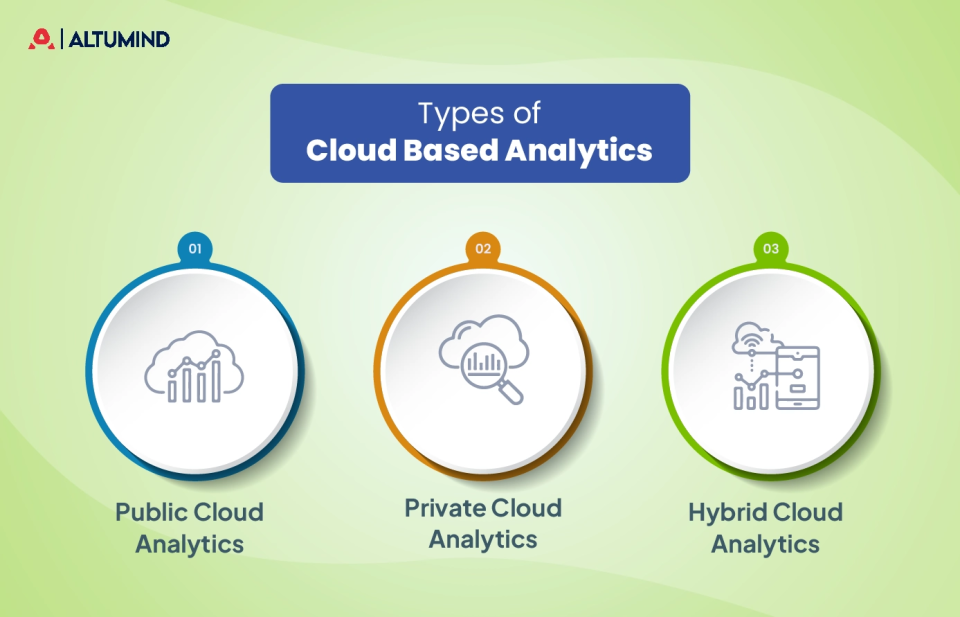
Types of Cloud Based Analytics
Public Cloud Analytics
Public cloud analytics operates on infrastructure provided by third-party vendors such as AWS, Microsoft Azure, or Google Cloud. Here, businesses share the same computing resources while still keeping their data secure through dedicated environments. The advantage lies in cost efficiency and scalability, as enterprises pay only for the resources they consume. Public cloud analytics is best suited for organizations that prioritize speed of deployment, lower upfront investment, and broad accessibility.
Private Cloud Analytics
Private cloud analytics is hosted on infrastructure dedicated solely to one organization. It can be managed internally or through a specialized vendor. The biggest strength is control: businesses gain tighter security, compliance oversight, and customization options that align with specific regulatory needs. This type is particularly valuable for industries such as healthcare, banking, or defense, where data sensitivity and governance requirements are strict.
Hybrid Cloud Analytics
Hybrid cloud analytics combines the strengths of both public and private models. Enterprises can keep highly sensitive data in a private environment while shifting less sensitive workloads to the public cloud for scalability. This balance offers flexibility: it reduces costs without sacrificing control over critical assets. Hybrid models are increasingly favored by large enterprises seeking resilience, agility, and the ability to handle varying data workloads across global operations.
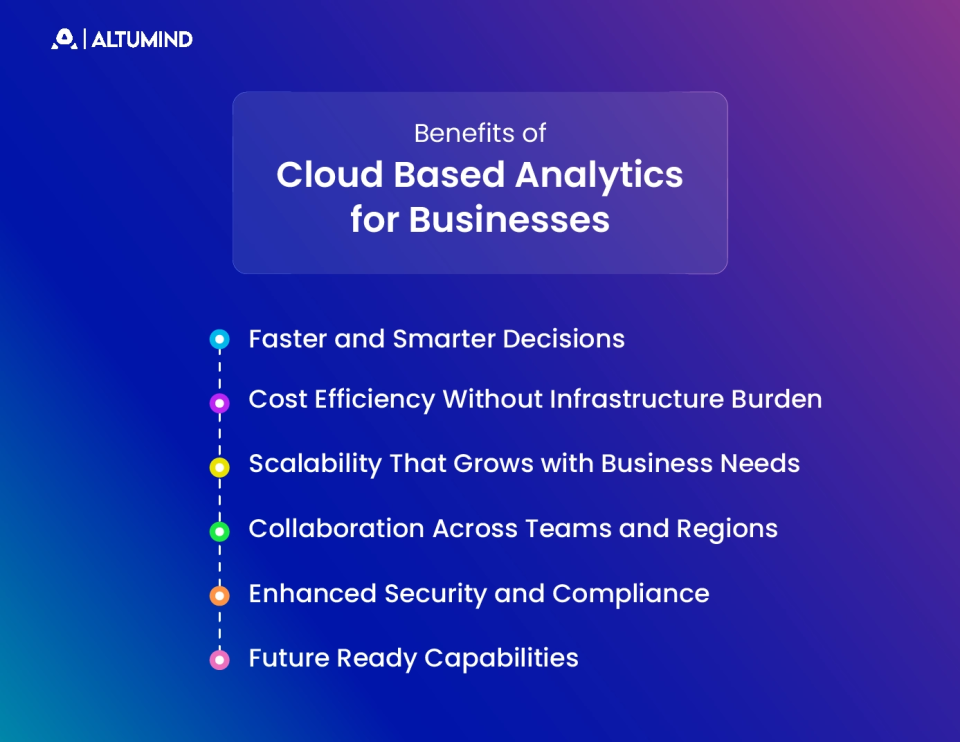
Benefits of Cloud Based Analytics for Businesses
Faster and Smarter Decisions
Data analytics in the cloud turns information into insights in real time. Instead of waiting days for reports, leadership teams can see live dashboards and react instantly to market shifts or operational changes. This speed of insight allows companies to act with precision, whether it is adjusting pricing strategies, responding to customer behavior, or allocating resources. For executives, faster decisions mean sharper competitiveness in environments where hesitation can cost market share.
Cost Efficiency Without Infrastructure Burden
Building on-premise infrastructure for analytics requires heavy investment in servers, maintenance, and skilled staff. Cloud based models remove that barrier by offering a pay-as-you-use approach. Businesses only consume the storage and computing power they need, scaling up during peak demand and scaling down when activity slows. This reduces waste, lowers capital expenditure, and redirects budgets toward innovation rather than upkeep.
Scalability That Grows With Business Needs
As organizations expand, their data volumes increase significantly. Cloud based analytics adapts seamlessly, handling everything from seasonal spikes in e-commerce to global expansion of operations. Leaders no longer need to predict future capacity years ahead; scalability in the cloud makes growth less risky and more manageable, supporting long-term strategies with confidence.
Collaboration Across Teams and Regions
Data confined to one department limits its potential. With cloud analytics, all teams, including finance, marketing, operations, and product, can access the same version of truth in one place. This centralization breaks down silos and encourages collaboration across geographies. Executives benefit from better alignment between units, reducing conflicts caused by inconsistent data and strengthening enterprise-wide decision-making.
Enhanced Security and Compliance
For CEOs and CTOs, security remains a non-negotiable concern. Modern cloud platforms integrate encryption, multi-factor authentication, and role-based access to protect sensitive information. They also adhere to international compliance frameworks such as GDPR, HIPAA, or SOC; this makes them reliable partners for regulated industries. The combination of speed and safety assures leaders that agility does not come at the cost of protection.
Future-Ready Capabilities
Cloud based analytics is not only about current insights; it also integrates AI, machine learning, and predictive modeling. These technologies move beyond describing what has happened to forecasting what could happen. For businesses, this means anticipating customer behavior, forecasting supply chain disruptions, and identifying new opportunities before they become visible to competitors. It positions enterprises to thrive in the future, not just survive in the present.
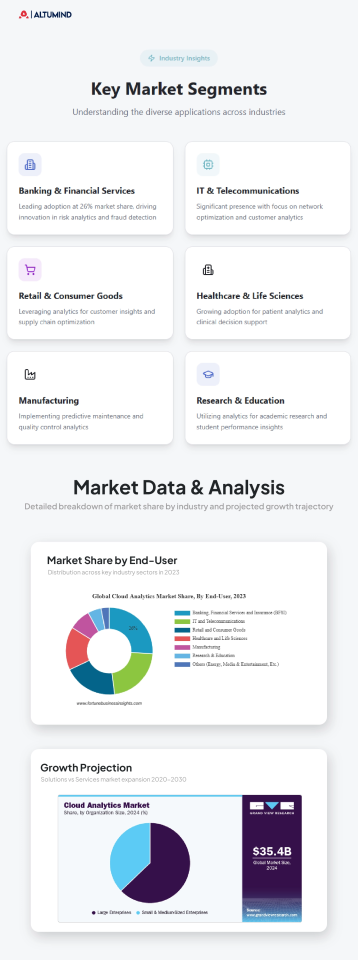
How Cloud Based Analytics Transforms Industries
Healthcare
Healthcare organizations manage vast amounts of patient data, medical records, and diagnostic results. The digitization of healthcare using AI, supported by cloud based analytics, enables providers to bring this information together in one place. It improves patient outcomes, reduces administrative delays, and reveals patterns in disease management. With predictive models, hospitals can anticipate admissions and allocate resources more effectively, resulting in higher efficiency and lower costs.
Financial Services
Banks and financial institutions require precise risk analysis and fraud detection. Cloud based analytics offers powerful tools for monitoring transactions, flagging anomalies, and running predictive models that assess creditworthiness. By processing data at scale, financial institutions can respond faster to threats and deliver personalized financial products with greater accuracy.
Manufacturing
Manufacturers generate massive datasets from equipment sensors, production lines, and supply chains. Cloud analytics turns this into real-time insights on equipment performance and predictive maintenance. This reduces downtime, prevents costly failures, and improves production efficiency. Supply chain visibility also improves, allowing manufacturers to align output with demand more effectively.
Telecommunications
Telecom companies manage billions of data points daily from network usage, customer calls, and device interactions. Cloud based analytics helps providers optimize bandwidth, predict network outages, and offer customized packages to customers. This leads to better service reliability and improved customer satisfaction while reducing operational strain.
Retail and E-Commerce
In retail, customer behavior shifts rapidly. Cloud analytics enables companies to track purchasing trends in real time, personalize recommendations, and optimize supply chain operations. Overcoming challenges of eCommerce is critical for growth, and cloud based analytics plays a central role by helping platforms adjust inventory levels, refine pricing, and build customer loyalty. The result is higher revenue and reduced waste, even in competitive markets.
Government and Public Sector
Government agencies deal with public data that must be accurate and secure. Cloud analytics supports initiatives in urban planning, traffic control, and resource distribution. By analyzing citizen data responsibly, agencies improve service delivery, reduce inefficiencies, and enhance transparency.
Difference Between Traditional and Cloud Based Analytics
| Aspect | Traditional Analytics | Cloud-Based Analytics |
|---|---|---|
| Infrastructure | Requires heavy investment in on-premise servers and hardware | Runs on virtual infrastructure provided by cloud vendors |
| Scalability | Limited, needs new hardware and a long setup time | Elastic scaling expands or contracts instantly based on demand |
| Cost Model | High upfront capital expenditure, ongoing maintenance costs | The pay-as-you-use model reduces capital expenses |
| Deployment Speed | Slow, requires installation and configuration | Fast, provisioned quickly through cloud platforms |
| Data Access | Restricted to specific devices and locations | Accessible anytime, anywhere with internet connectivity |
| Collaboration | Data often siloed and harder to share across teams | Centralized data enables seamless cross-team collaboration |
| Updates and Maintenance | Requires in-house IT teams for upgrades | Automatic updates handled by the cloud provider |
| Security | Security managed internally, risk of outdated measures | Built-in encryption, compliance frameworks, and provider-driven updates |
| Performance | Dependent on physical server capacity | High performance with distributed computing and advanced engines |
| Future Readiness | Difficult to integrate with AI, ML, or IoT systems | Designed to integrate with AI, ML, and advanced technologies |
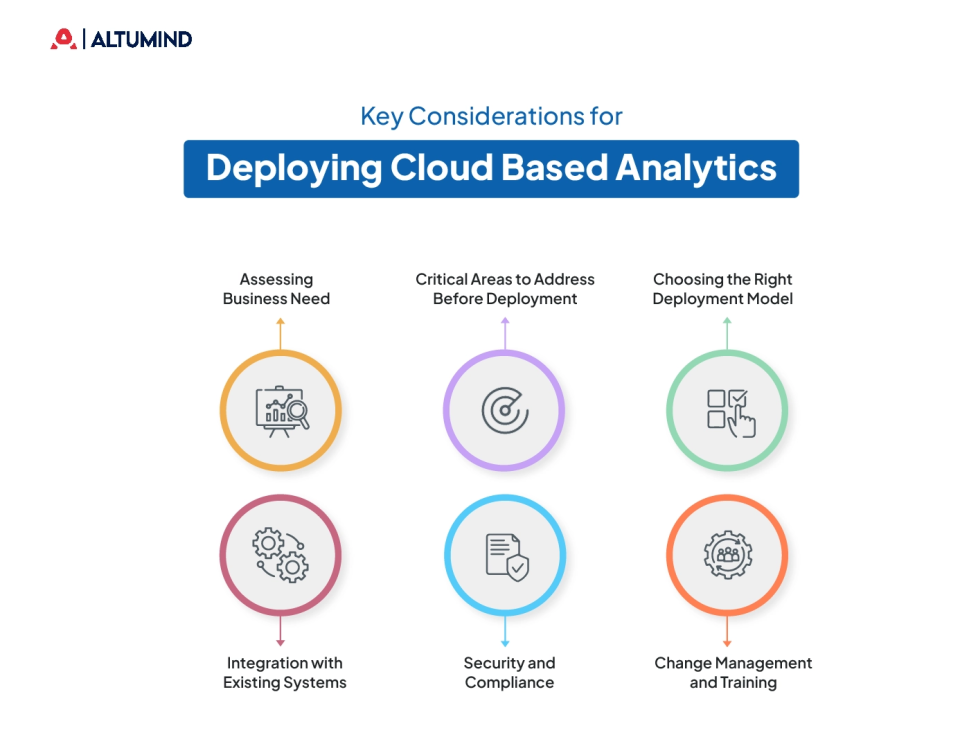
Key Considerations for Deploying Cloud Based Analytics
Assessing Business Needs
Before any deployment, leaders must understand the purpose cloud analytics will serve. Is the goal to improve operational efficiency, enhance customer experience, or enable predictive intelligence? Without this clarity, investments risk becoming underutilized. A needs assessment helps prioritize the right tools, platforms, and scale.
Critical Areas to Address Before Deployment
Enterprises should ask critical questions at the planning stage:
- Which business units will benefit most from cloud analytics?
- What type of data is most critical to decision-making?
- How will success be measured in terms of ROI or performance?
These questions guide alignment between technology and business objectives.
Choosing the Right Deployment Model
Organizations must evaluate whether a public, private, or hybrid cloud suits their needs. Highly regulated industries may favor private or hybrid models, while fast-growing businesses often find public clouds more practical. The choice impacts cost, compliance, and scalability in the long run.
Integration with Existing Systems
A major consideration is how cloud analytics will connect with current systems such as ERP, CRM, or HR platforms. Smooth integration ensures that analytics does not operate in isolation but enhances the flow of data across the enterprise. APIs and middleware play a central role here.
Security and Compliance
Data security remains a top concern for CEOs and CTOs. Leaders must confirm that vendors provide strong encryption, access control, and compliance with relevant standards such as GDPR or HIPAA. The right governance framework reduces risks and builds trust.
Change Management and Training
Analytics adoption is not just a technical shift; it is a cultural change. Teams need training to use dashboards and interpret insights correctly. Clear communication and leadership buy-in help accelerate adoption and prevent resistance from employees.
Future Trends in Cloud Based Analytics
AI and Machine Learning Integration
The future of cloud based analytics lies in intelligence that goes beyond reporting. Platforms are increasingly embedding machine learning and AI models that forecast demand, detect anomalies, and recommend strategies. This shift from descriptive to predictive and prescriptive insights helps businesses act before opportunities or risks fully emerge.
Edge Analytics for Faster Decisions
With the rise of IoT and connected devices, not all data can wait to be processed in the cloud. Edge analytics pushes computation closer to the source of data, such as sensors, devices, and gateways, allowing organizations to act instantly. This trend is critical for industries like manufacturing, healthcare, and telecom, where milliseconds matter.
Greater Focus on Data Governance
As data privacy regulations expand globally, governance will become a priority. Future cloud analytics platforms will strengthen compliance automation, offering built-in tools that track data lineage, enforce access rules, and provide transparent reporting. Decision makers will gain not only insights but also confidence in regulatory alignment.
Multi-Cloud and Hybrid Strategies
Organizations are moving away from relying on a single cloud provider. Multi-cloud and hybrid strategies allow enterprises to balance cost, performance, and compliance needs by using different providers for specific workloads. This trend reduces dependency risks and increases resilience in critical operations.
Democratization of Analytics
Cloud based analytics is becoming accessible to non-technical users through natural language queries and simplified dashboards. In the future, business leaders across departments will be able to interact directly with data without depending heavily on IT teams. This democratization expands the impact of analytics across the entire enterprise.
Wrapping Up
Cloud based analytics has moved beyond being a technology choice; it is now a strategic enabler that shapes smarter, faster, and more resilient business decisions. As enterprises continue to face rising data volumes and complex challenges, the shift to the cloud creates opportunities that traditional systems cannot match.
Are you ready to question whether your business is truly making the most of its data, or are valuable insights still slipping through the cracks? At Alumind, we specialize in delivering cloud application development services that align analytics with real business outcomes.
Contact us today to see how we can transform your data into a powerful growth engine and position your business ahead of the competition.
Table of Contents
- Introduction
- What is Cloud Based Analytics
- Scope of Cloud Based Analytics
- How Cloud Based Analytics Works
- Key Components of Cloud Based Analytics
- Key Technologies Driving Cloud Based Analytics
- Types of Cloud Based Analytics
- Benefits of Cloud Based Analytics for Businesses
- How Cloud Based Analytics Transforms Industries
- Difference Between Traditional and Cloud Based Analytics
- Key Considerations for Deploying Cloud Based Analytics
- Future Trends in Cloud Based Analytics
- Wrapping Up
Let's Connect
Reach out and explore how we can co-create your digital future!



